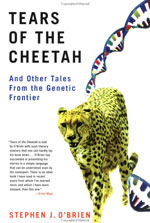Review of "Tears of the Cheetah"

Author(s): Stephen J. O'Brien
Published: Sept. 2003, Thomas Dunne Books, ISBN: 0312272863
 by James A. Huggins, Ph.D., University Professor & Director of the Hammons Center for Scientific Studies
by James A. Huggins, Ph.D., University Professor & Director of the Hammons Center for Scientific Studies
May 140, 2004 -
Tears of the Cheetah is an eye-opening testimony to the breadth of the contribution that molecular biology has made to the study of life. Author Stephen J. O’Brien has chronicled this stand-alone discipline’s value to the corporate nature of biology. Indeed, O’Brien makes application for his discipline in such diverse biological arenas as medical genetics, epidemiology, conservation biology, wildlife management, virology, immunology, and science history and it is evident throughout his book that molecular biology is leading the way in making all of science an interdisciplinary affair.
Our genome, if one knows what to look for, reads like both a blueprint and a history text. Within an organism’s DNA, ancestral struggles and triumphs from long ago are chronicled at the molecular level. These environmental offenses brought to bear against the species and the individual organism, whether in the form of interspecific competition or viral infection, shape the corporate and individual strengths and weaknesses of those creatures which live long enough to reproduce. Consequently, an on-going molecular story is inscribed within and elucidated by the genomic sequences of those who survive. Empowered with the knowledge provided by this relatively new and extremely powerful branch of science, molecular biology, it is imperative that we, as the caretaker species of earth, decipher and use this information wisely.
The case studies derived from O’Brien’s work with endangered species, chapters one through nine, will be especially scintillating for the student that enjoys a good mystery, appreciates the diversity of God’s creation, and is imbued with a fondness of all creatures. These same chapters will be edifying as the reader observes application and discovery being woven into the management plans for species threatened by the encroachment of man. Species such as the Florida panther, African lion, Giant panda, orangutan, and the cheetah represent part of God’s creation and therefore fall within the realm of our Christian stewardship and responsibility. We must do all that is within our power to keep them from going the way of extinction. To achieve this goal we must first understand them, every conceivable aspect, as best we can. Just as A Sand County Almanac and Silent Spring served to bring professional biologists and the public alike to an awareness of the crisis of conservation issues, this book should bring us to the realization that another ray of hope has been added to the arsenal of technique and knowledge being used to conserve our biological heritage. In addition, O’Brien is masterful in making the transition from animal to human application and in making the case, for those that are inclined to see the value of research from a singularly human standpoint, that basic nonhuman investigations often unearth wonderful treasures that direct toward human use. We, as a species, have and will continue to benefit from the molecular stories of triumph and tragedy that other species tell. While I can not agree with his take on his early religious training in chapter 10, his thought processes are representative of the marriage of Christian and secular biological thought.
Stephen J. O’Brien’s thirty years of excavating mammalian genomes as an NIH geneticist have given him the experience to speak with authority and insight to the many uses of molecular biology; his training and intellect have allowed him to deduce meaning from the molecular hieroglyphics he has investigated along the way; his love of the sum of nature has taken him on a marvelous journey and has allowed him to make contributions above and beyond what his day job required. He has lived his purpose and calling on this earth. Despite its failings on the spiritual front, I heartily recommend this book for any aspiring young biologist.

